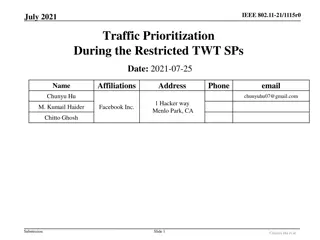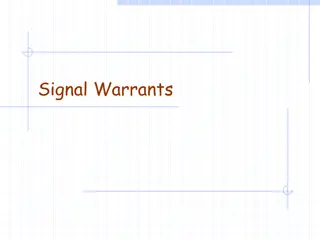Understanding Traffic Flow Theory and Shock Waves in Transportation Engineering
Explore fundamental principles of traffic flow, applications of traffic flow theory, shock waves in traffic streams, and types of shock waves in transportation engineering. Learn about determining lane lengths, estimating delays, and analyzing shock wave behaviors in various traffic scenarios. Delve into examples and velocity calculations related to shock waves for a comprehensive understanding of traffic engineering concepts.
Download Presentation

Please find below an Image/Link to download the presentation.
The content on the website is provided AS IS for your information and personal use only. It may not be sold, licensed, or shared on other websites without obtaining consent from the author. Download presentation by click this link. If you encounter any issues during the download, it is possible that the publisher has removed the file from their server.
E N D
Presentation Transcript
CE 34500 Transportation Engineering Chapter 6: Fundamental Principals of Traffic Flow 2
Applications of Traffic Flow Theory Determine adequate lane lengths for storing left turn vehicles on separate left turn lanes 3
Applications of Traffic Flow Theory Average delay at intersection. Average delay at freeway ramp merging areas. Estimate backups and queuing due to a crash, work zones, signal turning red etc. 4
Example of Shock Waves Example: https://www.youtube.com/watch?v=6Z C9h8jgSj4 6
Shock Waves in Traffic Streams 7
Shock Waves at Signalized Intersection 8
Types of Shock Waves Frontal Stationary: Occurs when the capacity suddenly reduces to zero (i.e., closed lanes because of an accident) Backward Forming: Formed when the capacity is reduced below the demand flow rate. Results in an upstream queue at the bottleneck (i.e., signal indication on an interchange becomes red) Backward Recovery: Formed when the demand flow rate becomes less than the capacity of the bottleneck (i.e., signal indication on an interchange becomes green) Rear Stationary and Forward Recovery: Occurs when the demand flow rate upstream of a bottleneck is first higher than the capacity of the bottleneck and then the demand flow rate reduces to the capacity of the bottleneck (i.e., peak hours in a tunnel) 9
Velocity of Shock Waves Example: uw: shock wave moving speed at the density separation line k1: higher traffic density k2: lower traffic density u1: space mean speed of vehicles in traffic with density k1 u2: space mean speed of vehicles in traffic with density k2 q1 (flow rate) = k1 x u1 q2 (flow rate) = k2 x u2 q uw = q 2 1 k k 2 1 10
Example 6.5 11
Shock Wave by Slow Traffic 12
Example 6.6 13
Gap Acceptance A driver who intends to merge must evaluate the available gaps to determine which gap (if any) is large enough to accept the vehicle Driver feels that the merging maneuver can be completed safely to join the new stream This phenomenon is called gap acceptance 14
Introduction to Queuing Theory One of the greatest concerns to engineers is the congestion that exists on urban highways, especially during peak hours The queues occur on expressway on-ramps and off-ramps, signalized and unsignalized intersections, and on arterials Mathematical algorithms are used to analyze queuing: Deterministic Analysis: Assumes that all the traffic characteristics of the queue are deterministic and demand volumes and capacities are known Stochastic Analysis: Considers characteristics such as arrival rates are not deterministic that certain traffic 15
Deterministic Analysis Consider a one direction, three-lane highway with a maximum service volume of c veh/h An incident results in the closure of one lane and drops the capacity to cR for a period of tinc hr Demand volume continues to be V veh/h The maximum queue length can be determined as: 16
Queuing Diagram for Incident Situation 17
Example 6.10 18
Summary Efficient use of any highway system entails the flow of the maximum volume of traffic without causing excessive delay to the traffic and inconvenience to the motorist. Using the appropriate model for a traffic flow will facilitate the computation of any change in one or more elements due to a change in another element 19























